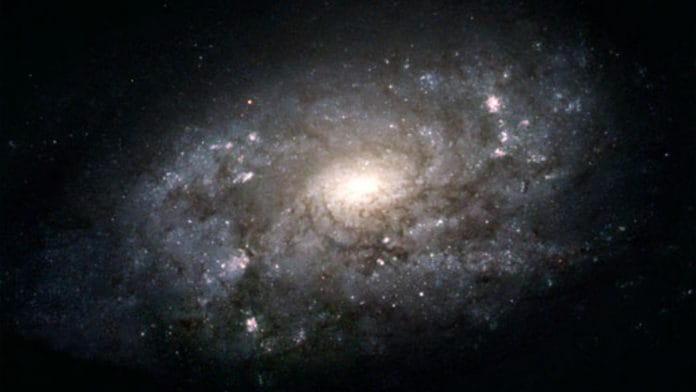New Delhi: A new paper by scholars from the University of Pennsylvania, published on 26 June in The Astrophysical Journal Letters looks at three tiny bright celestial objects discovered by the James Webb Space Telescope (JWST) and their origins, and explains that these objects emit light that has signatures of both really old stars and supermassive black holes.
The scientists have been unable so far to confirm the exact nature of these objects. They are, however, defined as old galaxies with evidence of supermassive black holes and ancient stars within them.
According to the paper, more analysis is required to understand how the existence of these objects fits into our current understanding of how galaxies are formed, and especially how the Milky Way was formed.
Found in July 2022 by the JWST, these objects date back to 600-800 million years after the Big Bang, the early days of the universe. The study looks at the different wavelengths of light emitted by these objects to analyse the signatures present in them. This light already holds the record for the oldest signatures of starlight, and scientists confirm that they are packed with ancient stars that are hundreds of millions of years old.
Additionally, they also emit signatures of supermassive black holes that are expected to be 100 times the size of the supermassive blackhole present in the Milky Way. Read more here.
CO2 emissions could shift tropical rains upwards
A new study led by University of California, Riverside, predicts that climate change will impact rainfall, profoundly impacting agriculture and economies near the equator.
According to the research published in Nature on 28 June, the shift results from atmospheric changes affecting the intertropical convergence zones (ITCZ) — regions near the equator where trade winds from both the tropics (Northern and Southern) meet.
The ITCZ convergence leads to the formation of thunderclouds and rainfall, accounting for a third of the world’s total rain. Regions such as Central Africa, Northern South America, and Pacific island states will be most affected by this shift.
The study used climate models to simulate increased carbon dioxide emissions, showing the ITCZ shifting northward by 0.2 degrees. This shift will last around 20 years before warming southern oceans pull the zones southward for a millennium.
This movement could cause significant changes in agriculture and economies, as the ITCZ areas receive heavy rainfall, essential for tropical rainforests and farming. Read more here.
Flourishing biodiversity in Coral Triangle
Researchers from the University of Bonn and Hong Kong together deconstructed the history of the marine biodiversity hotspot known as the ‘Coral Triangle’ in the Indo-Australian archipelago.
The paper, published in Nature on 26 June, observes the region, which is known to have the richest marine biodiversity in the world, and finds that tectonic activity, moderation of excessive heat some 14 million years ago, and lack of any large extinction events, allowed for the flourishing of biodiversity in the habitat.
The researchers looked at sediment samples from the archipelago to understand how the biodiversity evolved around the early Miocene period (20 million years ago), and then how it persisted over the millennia.
Since the reduction of atmospheric heat played a huge role in the expansion of species in the region, the study also warns that the current anthropogenic warming could threaten this biodiversity. Read more here.
Air pollution & bronchitis
A team led by University of Southern California’s Keck School of Medicine has shown that exposure to air pollution during childhood is directly associated with bronchitis symptoms in adulthood.
Published in the American Journal of Respiratory and Clinical Care Medicine on 25 June, the study utilised data from the USC Children’s Health Study, following participants from childhood into adulthood.
It assessed the impact of exposure to nitrogen dioxide, particulate matter 2.5 and particulate matter 10 on a sample size of 1,308 participants. During the adult assessment, 25 percent of the total participants reported bronchitis symptoms. Most of the participants were non-Hispanic White or Hispanic.
Surprisingly, the link persisted even after adjusting for early-life asthma or bronchitis symptoms. The results suggest that exposure to air pollution in childhood has subtle effects on the respiratory system that impact humans in adulthood. The study emphasises the importance of reducing exposure to air pollution, especially during childhood, as children are particularly vulnerable due to their developing respiratory systems. Read more here.
(Edited by Mannat Chugh)
Also Read: Milky Way’s last big collision with another galaxy was much more recent than previously thought






